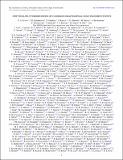SWIFT FOLLOW-UP OBSERVATIONS OF CANDIDATE GRAVITATIONAL-WAVE TRANSIENT EVENTS
Author(s)
Fridriksson, Joel K.; Homan, Jeroen; Bodiya, Timothy Paul; Corbitt, Thomas R.; Donovan, Frederick J.; Dwyer, S.; Evans, Matthew J.; Foley, Stephany; Fritschel, Peter K.; Katsavounidis, Erotokritos; Kissel, Jeffrey S.; Kwee, Patrick; MacInnis, Myron E.; Mason, Kenneth R.; Matichard, Fabrice; Mavalvala, Nergis; McDaniel, P.; Mittleman, Richard K.; Oelker, Eric Glenn; Sankar, S.; Shapiro, B.; Shoemaker, David H.; Smith-Lefebvre, Nicolas D.; Vaulin, Ruslan; Waldman, Samuel J.; Weiss, Rainer; Wipf, Christopher Conrad; Zucker, Michael E.; ... Show more Show less
DownloadEvans-2012-SWIFT FOLLOW-UP OBSE.pdf (900.6Kb)
PUBLISHER_POLICY
Publisher Policy
Article is made available in accordance with the publisher's policy and may be subject to US copyright law. Please refer to the publisher's site for terms of use.
Terms of use
Metadata
Show full item recordAbstract
We present the first multi-wavelength follow-up observations of two candidate gravitational-wave (GW) transient events recorded by LIGO and Virgo in their 2009-2010 science run. The events were selected with low latency by the network of GW detectors (within less than 10 minutes) and their candidate sky locations were observed by the Swift observatory (within 12 hr). Image transient detection was used to analyze the collected electromagnetic data, which were found to be consistent with background. Off-line analysis of the GW data alone has also established that the selected GW events show no evidence of an astrophysical origin; one of them is consistent with background and the other one was a test, part of a "blind injection challenge." With this work we demonstrate the feasibility of rapid follow-ups of GW transients and establish the sensitivity improvement joint electromagnetic and GW observations could bring. This is a first step toward an electromagnetic follow-up program in the regime of routine detections with the advanced GW instruments expected within this decade. In that regime, multi-wavelength observations will play a significant role in completing the astrophysical identification of GW sources. We present the methods and results from this first combined analysis and discuss its implications in terms of sensitivity for the present and future instruments.
Date issued
2012-11Department
Massachusetts Institute of Technology. Department of Physics; LIGO (Observatory : Massachusetts Institute of Technology); MIT Kavli Institute for Astrophysics and Space ResearchJournal
The Astrophysical Journal. Supplement Series
Publisher
IOP Publishing
Citation
Evans, P. A., J. K. Fridriksson, N. Gehrels, J. Homan, J. P. Osborne, M. Siegel, A. Beardmore, et al. “SWIFT FOLLOW-UP OBSERVATIONS OF CANDIDATE GRAVITATIONAL-WAVE TRANSIENT EVENTS.” The Astrophysical Journal Supplement Series 203, no. 2 (November 21, 2012): 28. © 2012 The American Astronomical Society
Version: Final published version
ISSN
0067-0049
1538-4365